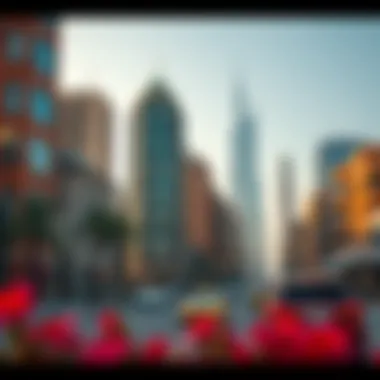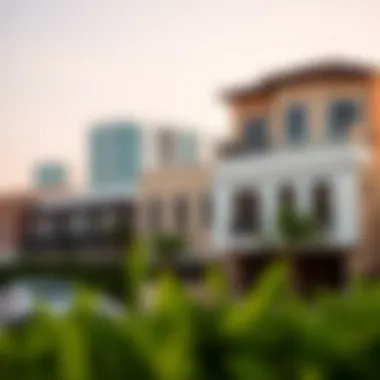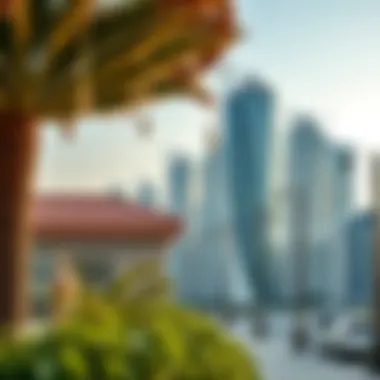Exploring the Unique Neighborhoods of Dubai


Intro
Dubai, often termed as the jewel of the desert, is a city where innovation meets tradition. This bustling metropolis is more than just a tapestry of glitzy skyscrapers and lavish shopping malls; it’s a mosaic of neighborhoods, each offering distinct lifestyles and cultural flavors. To truly grasp the essence of Dubai, one must delve into its diverse enclaves, which reflect the city’s dynamic nature and its rapidly changing demographics.
Understanding these neighborhoods can unveil lucrative investment opportunities while also providing insights into what it’s like to live in each area. From the historic corners of Al Fahidi to the modern developments in Dubai Marina, each locality showcases its own charm and lifestyle benefits. In this guide, we aim to navigate through the multifaceted neighborhoods in Dubai, highlighting key characteristics, demographic insights, and real estate trends together with practical aspects that appeal to investors, homebuyers, and expatriates alike.
As we explore further, we’ll look at why certain locales rise as investment hotspots and how they integrate contemporary living with community-based amenities. With an eye on the future, this article is tailored for anyone looking to unpack the treasures embedded within the neighborhoods of a city that continues to redefine itself.
Prolusion to Dubai's Real Estate Landscape
Dubai's real estate scene is not just about shiny skyscrapers and luxurious villas; it's a tapestry woven from various threads, each representing a different neighborhood with its unique character and appeal. Understanding this landscape is crucial, especially for investors, homebuyers, and expatriates who are considering making Dubai their home. The city has transformed rapidly over the years, thanks to its ambitious development projects and strategic positioning as a global hub for business and tourism.
The city's neighborhoods represent a broad spectrum of lifestyles, from the ultra-modern in Downtown Dubai to the cultural richness of Old Dubai. This diversity is pivotal for potential residents and investors, as it reflects the complex social fabric of the city. The choice of neighborhood can influence not only the living experience but also the return on investment in real estate.
Moreover, the Dubai real estate market is known for its blend of contemporary living and traditional values. In areas like Jumeirah, residents enjoy a beachside lifestyle intertwined with local customs, while the vibrant atmosphere of Dubai Marina caters to a younger, cosmopolitan crowd. This variety is beneficial for investors who wish to tailor their property portfolios to attract specific demographics.
Why Understanding Dubai's Real Estate Landscape Matters
- Investment Opportunities: Knowing the ins and outs of each neighborhood helps in identifying areas with high growth potential.
- Lifestyle Choices: Different neighborhoods offer varied amenities, from luxurious dining options to family-friendly parks. Each choice caters to a different demographic.
- Market Trends: Real estate trends can vary significantly from one area to another in Dubai. A deep understanding facilitates better timing for buying or selling properties.
- Cultural Considerations: Dubai is a melting pot of cultures. Understanding the demographics aids in adapting to community vibes and engaging with neighbors effectively.
As the city continues to evolve, being aware of the distinctive nuances in Dubai’s neighborhoods will empower potential buyers and investors. They can make informed decisions that align with their investment goals and lifestyle preferences.
"Real estate may not be the most exciting industry, but it provides the foundation for living, working, and playing in one of the world's most dynamic cities."
The following sections will delve deeper into specific neighborhoods, shedding light on their features and investment viability, equipping readers with the essential insights required for navigating Dubai’s diverse real estate landscape.
An Overview of Dubai's Architectural Identity
Dubai's architectural landscape is a striking blend of tradition and modernity, showcasing the city’s rapid transformation over the past few decades. This metamorphosis has turned Dubai into a global hub, where the sands of the desert now cradle countless shimmering structures. Each building tells a story, reflecting the aspirations of a city that dreams big.
When discussing architectural identity in Dubai, it's crucial to appreciate the variation evident throughout its neighborhoods. From opulent skyscrapers in Downtown to the Arabic-influenced designs in Old Dubai, the city's architectural diversity captures its cultural tapestry. This variety not only enhances the city's skyline but also promotes an understanding of Dubai’s social fabric—where East meets West in harmonious coexistence.
One of the most remarkable aspects of Dubai's architecture is the influence of visionary projects. Iconic structures such as the Burj Khalifa stand as testaments to human ingenuity and ambition. However, it’s the smaller architectural gems that often go unnoticed—traditional wind towers and bustling souks that speak to a rich history. This juxtaposition of the old and the new forms a backbone for understanding the broader socio-economic context of the city.
Benefits of Understanding Architectural Identity
- Cultural Appreciation: Grasping the context of architectural styles leads to a deeper appreciation for the diverse cultures that have shaped the city's identity.
- Investment Insights: Investors can discern which areas might see future expansion or renovation based on architectural trends, guiding their investments strategically.
- Tourism Potential: Unique architecture serves as magnets for tourists, creating economic opportunities for local businesses.
In delving into the architectural identity, one might also consider how the skyline impacts urban planning and development strategies. Greater emphasis on sustainable designs is emerging, with many developers incorporating environmentally friendly technologies into new projects. As a result, the architecture not only serves aesthetic purposes but also addresses global concerns about sustainability and reserves resources for future generations.
Additionally, the architectural narrative in Dubai isn't static. It evolves as developers introduce new styles and technologies, pivoting with the trends while remaining grounded in tradition. This fluidity keeps the city vibrant, continually enriching the lives of its inhabitants.
"The art of building in Dubai is not just about structures; it’s about the soul of a city that refuses to remain stagnant."
Thus, examining the architectural identity of Dubai is more than skin-deep. It provides essential context for understanding urban living, community dynamics, and investment opportunities in this rapidly changing environment. As one navigates the neighborhoods of this ever-evolving metropolis, the architectural identity forms an essential guide—helping residents, investors, and visitors alike appreciate what lies beyond the facade.
Historical Evolution of Neighborhoods
The journey through Dubai's neighborhoods is akin to turning the pages of a vibrant storybook, each chapter revealing unique characters and tales from the past. Understanding the historical evolution of these areas is crucial for investors, homebuyers, and expatriates who seek to grasp the dynamics of the current market.
Dubai was not always the bustling metropolis we see today. In fact, its roots trace back to a humble fishing village in the 19th century. As the discovery of oil in the mid-20th century catalyzed rapid growth, the neighborhoods transformed significantly. This historical backdrop is not only fascinating but also provides insight into current trends and investment potential.
Key Elements of Evolution
- Cultural Melting Pot:
- Urban Planning Changes:
- Transport Links:
- Real Estate Shifts:
- Dubai has served as a crossroads of trade and culture. As businesses expanded and expatriates settled, diverse ethnic communities began to sprout, shaping the fabric of neighborhoods like Jumeirah and Al Quoz. This multicultural environment enhances community life today, attracting those looking to connect in a dynamic space.
- The city’s planning has constantly adapted. Iconic architectural developments emerged in response to economic booms and changing demographics. Areas like Downtown Dubai and Dubai Marina reflect contemporary desires for luxurious living intertwined with leisure and commerce, driven largely by expatriate populations and high-net-worth individuals.
- The evolution of public transportation, such as the introduction of the Dubai Metro, decisively impacted the accessibility of neighborhoods. This connectivity fosters growth in previously overlooked areas. Investors looking to tap into emerging neighborhoods can gain valuable insights by studying transportation patterns and growth indicators.
- The shift from traditional to modern housing reflects not only changing lifestyles but also reveals economic trends. Areas like Old Dubai are witnessing a revival, with investments focusing on preserving heritage while meeting modern demands. The relocation of young families towards newer developments showcases evolving preferences.
Benefits of Understanding Neighborhood Evolution


- Investment Predictability: For investors, knowing how neighborhoods have evolved can lead to informed decision-making. Long-term trends often repeat themselves, and historical data can suggest where future growth may occur.
- Community Insights: Homebuyers benefit from understanding how cultures have blended within a neighborhood. An area's historical significance can enhance community ties and provide a sense of belonging for new residents.
- Awareness of Future Developments: Keeping an eye on historical trends allows developers and stakeholders to anticipate future shifts. Being ahead of the curve can make a substantial difference in project viability and success.
In summary, the historical evolution of neighborhoods in Dubai tells a story of transformation, resilience, and diversity. By diving into the past, stakeholders can equip themselves with the knowledge needed to navigate the future real estate landscape with confidence. Understanding these elements ultimately aids in making savvy decisions, whether it be in investment, living, or developing new projects.
"The past informs us of the present, paving the way for tomorrow's opportunities."
For a deeper dive into Dubai's history, visit Encyclopedia Britannica.
Key Neighborhoods in Dubai
Dubai is a city known for its diverse neighborhoods, each presenting unique offerings and environments. Understanding key neighborhoods is crucial for anyone considering relocation or investment. These areas not only reflect the culture and lifestyle of residents but also determine the real estate values and community dynamics. Furthermore, potential residents and investors benefit from being informed about the differences in amenities, accessibility, and social atmosphere offered by each neighborhood.
Downtown Dubai
Iconic Landmarks and Developments
Downtown Dubai stands as the pulsating heart of the city, housing remarkable landmarks like the Burj Khalifa and The Dubai Mall. These structures are not just architectural feats but vital to the economic fabric of Dubai. Visitors and residents alike flock to these sites, making this neighborhood a catalyst for social interaction and tourism. The distinctiveness of having such grandiosity right outside one’s door contributes to its attractiveness. However, with high demand comes a surge in property values, making it less accessible for some buyers.
Investment Viability
The investment prospects in Downtown Dubai are robust and continually evolving. Investors find this area appealing due to its high rental yields and potential for capital appreciation. Properties here are consistently in demand given its proximity to landmarks and amenities. However, potential buyers should be cautious of the market fluctuations and competition—properties may come with a hefty price tag, leading to high entry costs for new investors.
Community Lifestyle
Living in Downtown Dubai offers a vibrant community lifestyle. The area is often buzzing with residents enjoying its numerous parks, events, and dining options. Its walkability enhances interactions among residents, promoting a sense of community. Still, the rapid urban pace might not suit everyone, as it can sometimes feel overwhelming, particularly for those seeking quieter residential areas.
Dubai Marina
Luxury Waterfront Living
Dubai Marina epitomizes luxury living with its stunning views and an array of waterfront properties. Residents enjoy the picturesque landscapes along the marina, coupled with high-end living spaces. This combination makes it incredibly appealing to affluent buyers and renters alike. However, the price of such luxury can be prohibitive for many—a double-edged sword that contributes to its glamorous image but limits accessibility.
Dining and Nightlife Options
When it comes to nightlife, Dubai Marina does not disappoint. The area is home to a myriad of restaurants, cafes, and bars that offer diverse culinary experiences and vibrant nightlife. This lively scene draws both locals and tourists, ensuring a continuously bustling atmosphere. On the flip side, with popularity comes noise and crowds, which may deter those looking for a more tranquil living environment.
Rental Market Insights
The rental market in Dubai Marina is thriving, characterized by high demand from expatriates and professionals. Many see it as an ideal place to live given its amenities and views. Renters can expect competitive prices, but this high demand feeds into rising rental costs, which might stretch budgets for some.
Palm Jumeirah
Exclusivity and Prestige
Owning a property on Palm Jumeirah is synonymous with prestige. This man-made island is not just an engineering marvel but a symbol of wealth and luxury. It is positioned to draw those who prioritize exclusivity in lifestyle and real estate. However, such exclusivity comes with a price; properties are often at the higher end of the market, limiting access for average buyers.
Real Estate Trends
The real estate market on Palm Jumeirah has seen fluctuating trends, with ongoing interest from international investors. The diverse range of available properties from villas to apartments caters to various preferences. But, this desirability can lead to speculation, making it crucial for investors to do diligent market research before committing.
Family-Friendly Amenities
Palm Jumeirah offers a plethora of family-friendly amenities, from private beaches to parks and schools, catering to families looking for a well-rounded residential lifestyle. These features contribute to its appeal; however, ongoing development pressure might pose challenges with regards to space and services in the future.
Jumeirah
Cultural Significance
Jumeirah is deeply woven into the fabric of Dubai's culture, marked by its historical significance and preservation efforts. The neighborhood boasts iconic sites such as the Burj Al Arab alongside traditional markets. This unique blend of modern and heritage attracts those interested in a culturally rich living experience, although it might drive up property prices given its desirability.
Property Types and Prices
In Jumeirah, a variety of property types is available—ranging from luxury villas to apartments. Prices can vary significantly, driven by the specific location within the area. The challenge for buyers lies in navigating these variations while also considering ongoing shifts in the market, which can impact overall value.
Public Spaces and Recreation


Public spaces in Jumeirah, such as beaches and parks, are crucial for community engagement and recreational opportunities. These spaces promote healthy lifestyles and social interactions among residents. However, as the neighborhood continues to develop and attract visitors, ensuring these amenities are maintained can be a challenge.
Old Dubai
Heritage and Culture
Old Dubai represents the city’s historical roots and cultural depth. With areas like Al Fahidi and the Dubai Museum, it offers a glimpse into the past, blending traditional architecture with vibrant markets. For anyone looking to connect with Dubai's heritage, this is the place to be. Still, the allure of modern developments may overshadow these culturally rich sites.
Market Activity
The real estate market in Old Dubai is often characterized by more affordable options compared to its glitzy counterparts. Increased interest in preserving the area has driven up activity, making it an attractive spot for investors seeking value. However, balancing modernization with preservation remains a key challenge in maintaining its charm.
Future Developments
As Old Dubai continues to evolve, future developments are on the horizon. New projects aim to integrate modern conveniences while retaining cultural integrity. This balancing act, while promising to enhance the area’s appeal, must also be approached cautiously to avoid alienating long-term residents and visitors alike.
Al Quoz
Art and Creativity Hub
Al Quoz has emerged as a creative hotspot in Dubai, with art galleries, studios, and cultural spaces. This eclectic environment attracts artists and creative professionals, fostering a community built on arts and expression. However, the transformation into a hub also brings potential issues, such as rising rents that could push out some local creatives.
Impact on Real Estate Values
The rise of Al Quoz as an art district has positively impacted its real estate values. Investors are eyeing properties not only for residential purposes but for studio and workspace. Yet, rapid developments may deter some long-term buyers concerned about the area's evolving character.
Community Initiatives
Numerous community-led initiatives are fostering a sense of belonging in Al Quoz, with art workshops and public events engaging different demographics. While these initiatives strengthen community ties, securing sustainable funding and ongoing participation can pose challenges.
Business Bay
Commercial and Residential Balance
Business Bay exemplifies a carefully balanced mix of commercial and residential developments. This duality appeals to professionals seeking to live where they work, creating a unique urban ecosystem. But the demand for commercial space can sometimes overshadow residential needs, leading to potential oversaturation in the market.
Accessibility and Transport Links
Accessible transport links in Business Bay connect residents to key areas around Dubai. Public transport, road networks, and proximity to Downtown contribute to its attractiveness. Still, heavy traffic during peak hours can hinder smooth commuting experiences for residents.
Trends in Property Development
The property development landscape in Business Bay is continuously evolving. Developers are focused on creating innovative spaces that blend living and working environments. However, staying abreast of these trends is critical for investors as the landscape can shift rapidly.
Residential Trends in Dubai Neighborhoods
With the ever-changing skyline and bustling streets of Dubai, understanding the residential trends in its neighborhoods is paramount. This knowledge not only aids potential homebuyers and investors in making informed decisions but also reflects the broader economic and cultural shifts happening within the city. The diverse neighborhoods of Dubai showcase varied lifestyles and offer a glimpse into the lifestyle benefits, amenities, and investment opportunities that are ripe for exploration.
The trends in residential areas reveal a lot about current market demands, preferences of residents, and the future direction of development within the city. For instance, factors such as proximity to workplaces, availability of public spaces, and the presence of educational institutions all play a critical role in influencing where people choose to settle. Moreover, with an increasing influx of expatriates from different corners of the world, understanding the demographic shifts can offer valuable insights into the evolving real estate landscape.
Market Demographics
When we delve into market demographics, it becomes evident that Dubai's population is as eclectic as its architecture. The city is home to a large expatriate community, with residents hailing from countries like India, Pakistan, the Philippines, the UK, and many more. According to data from Dubai Statistics Center, expatriates make up nearly 90% of the population, and their preferences in housing choices greatly influence market trends.
- Family vs. Singles: Many areas near schools and parks, such as Jumeirah, attract families looking for spacious villas. In contrast, neighborhoods like Dubai Marina and Business Bay are more favored by young professionals seeking a vibrant lifestyle.
- Price Sensitivity: Statistical trends highlight a strong demand for moderately priced units. Many investors are shifting towards emerging neighborhoods, which offer lower prices but significant potential for appreciation.
"Understanding market demographics isn't just about numbers; it's about connecting the dots between lifestyle aspirations and investment opportunities."
Emerging Neighborhoods
Emerging neighborhoods in Dubai present a fascinating opportunity for savvy investors and prospective residents alike. Areas like Dubai South, which are still in the growth phase, promise to draw interest due to government plans aimed at infrastructure and community development.
- Innovative developments: New residential complexes incorporate eco-friendly designs and smart home technology, appealing especially to environmentally conscious buyers.
- Cultural hotspots: Locations like Al Quoz are transforming into dynamic art districts, further signaling shifts in residential preferences. This artistic evolution brings with it unique living arrangements that cater to creative residents.
- Accessibility improvements: Ongoing projects like the Dubai Metro expansion are enhancing connectivity, which in turn supports property values in these up-and-coming areas.
Real estate professionals note that investing in these neighborhoods could yield high returns, especially as demand grows and availability decreases over time. Understanding the dynamics of these emerging areas is crucial for anyone looking to navigate Dubai’s multifaceted real estate market.


Lifestyle Considerations for Residents
When it comes to choosing a neighborhood in Dubai, lifestyle considerations often take center stage. Each area has its own vibe and character, making it crucial for potential residents, whether they are investors, homebuyers, or expatriates, to understand what life might look like in their prospective locale. Factors such as cultural diversity, community life, and nearby amenities play significant roles in shaping daily experiences.
Cultural Diversity and Community Life
Dubai is a melting pot of different cultures and nationalities. You'll find people from all walks of life. This diversity brings a unique flavor to community life. Residents often engage in various cultural events and festivals, fostering a sense of unity among different backgrounds.
Living in places like Jumeirah or Dubai Marina gives you an edge. The proximity to high-end dining and luxurious living spaces doesn’t just attract affluent communities; it also enhances social interactions. Communities celebrate various traditional festivals, often organizing events that encourage residents to participate, be it an Iftar during Ramadan or Holi for the Indian community.
Cultural events don't just enrich our lives; they also create connections. Building networks is simpler when you are among people sharing similar values and experiences.
Amenities and Services
Amenities are another critical consideration when evaluating neighborhoods in Dubai. Different areas provide varying levels of services and facilities, catering to family needs, leisure activities, and accessibility. For example, neighborhoods like Dubai Marina boast upscale shopping centers, parks, and recreational facilities, often within walking distance.
Public transport options vary too. Some districts are well-connected via the metro system, while others rely on taxi services and buses. Consequently, ease of commuting can greatly influence the quality of life.
- Healthcare Facilities: Access to good hospitals and clinics matters. Areas like Business Bay have various options that are recognized for their high-quality services.
- Educational Institutions: Families prioritize schools that are both reputable and nearby. Neighborhoods such as Jumeirah are known for their international schools, making it a practical choice for families with children.
- Recreational Zones: Parks, beaches, and fitness centers contribute to a healthy lifestyle. The options are plentiful, especially in areas like Al Quoz where art and community initiatives often flourish.
In summary, understanding lifestyle considerations in Dubai’s neighborhoods can significantly impact one's living experience. From cultural diversity and community engagement to the availability of amenities and services, these elements shape the fabric of daily life. Therefore, taking the time to evaluate these aspects is not only beneficial but necessary for making an informed decision.
Investment Prospects in Dubai's Neighborhoods
The investment landscape in Dubai is not merely a canvas painted with skyscrapers and luxury shops; it's an intricate tapestry of diverse neighborhoods that each tell their own tale of opportunity and growth. Understanding the unique investment potential in these areas is crucial for investors, homebuyers, and expatriates alike, who are hunting for the best returns or a home that suits their lifestyle.
Dubai's neighborhoods offer a mix of modernity and tradition, showcasing everything from bustling financial hubs to serene residential enclaves. This diversity is a driving force behind both the residential and commercial real estate market, making it crucial to analyze how various aspects play into investment prospects. Potential investors should take a closer look at what different neighborhoods offer, from location advantages to local amenities.
With Dubai positioned as a global city, its real estate market is filled with vibrant prospects, particularly in neighborhoods that exhibit increasing popularity. The migration of expatriates has shifted demand towards selected areas, making it essential to stay ahead of market trends to understand where the best investments lie.
Additionally, cultural factors and local regulations can shape investment levels. By scrutinizing these elements, investors can uncover hidden gems within neighborhoods that might have been overlooked.
Analyzing ROI
Return on investment (ROI) is a key metric that fuels the decision-making for investors. In Dubai, ROI can significantly vary by neighborhood, influenced by population density, local demand, and market conditions. Neighborhoods like Downtown Dubai, with premium pricing, often offer lower yields; conversely, locations such as Al Quoz are emerging with higher returns on investment as the art scene and mixed-use developments gain traction.
Factors Affecting ROI:
- Location: Proximity to business districts or leisure amenities drives demand.
- Market Trends: Understanding the trajectory, whether upward or downward, can affect future earnings.
- Property Type: Apartments may yield different returns compared to villas or commercial spaces.
Investors keen to analyze data can conduct comparable market analyses, which might reveal where the neighborhood stands in terms of both current and projected ROI. Utilizing resources like Dubai Land Department for accurate market data and insights can enhance decision-making.
Risk Factors to Consider
Investing in real estate is seldom a straightforward affair, particularly in a diverse market such as Dubai. While opportunities abound, certain risks could hinder potential profits or lead to unexpected losses.
Common Risks:
- Market Volatility: The real estate market can be fragile due to global economic shifts or local regulatory changes.
- Regulatory Changes: New laws or restrictions can affect property rights or usage.
- Cultural Barriers: Navigating different societal norms and regulations can complicate transactions for expatriates.
Investors must bear in mind that thorough due diligence before committing to a purchase will mitigate risks effectively.
A prudent step is to keep abreast of city planning initiatives, economic forecasts, and global events that might impact the market. By employing a careful approach and considering neighborhood dynamics, investors can significantly bolster their chances of favorable outcomes in Dubai's vibrant real estate landscape.
Culmination
In wrapping up this exploration of Dubai's neighborhoods, it’s crucial to grasp the significance of these diverse locations in the broader context of the city’s real estate landscape. Each neighborhood within Dubai is more than just a spot on a map; it’s a unique microcosm that reflects the ever-evolving culture, lifestyle, and opportunities that the city has to offer. This article has traveled through the varying character of neighborhoods, demonstrating how they cater not only to the residents but also to investors, homebuyers, and expatriates searching for their place in this bustling metropolis.
Consider the varied profiles of neighborhoods like Downtown Dubai, pulsating with commercial energy, or Old Dubai, rich in heritage. Each district presents distinct benefits for different demographics. This diversified offering creates a lively real estate market, where every investor has the potential to find a lucrative opportunity best suited to their needs.
Furthermore, as we've discussed the importance of amenities, accessibility, and community life, it’s essential to remember that these factors significantly impact property value and the overall living experience. Neighborhoods such as Dubai Marina and Palm Jumeirah illustrate how waterfront living appeals to both luxury seekers and families looking for a serene lifestyle with recreational outlets. On the other hand, Al Quoz showcases the fusion of art and commerce, enhancing property values and attracting a creative crowd.
In essence, understanding the subtleties and dynamics of each neighborhood allows prospective buyers and investors to make informed decisions. The insights gleaned from this examination should empower your journey, whether you're an experienced investor or a newcomer eager to immerse in the fabric of Dubai life.
As Dubai continues to grow and adapt, maintaining awareness of these neighborhood trends will serve anyone looking to navigate this vibrant city effectively. Getting a grasp on the economic and cultural aspects revealed throughout this article can make the difference between a hasty choice and a well-considered investment.
"Real estate in Dubai is not just about land and property; it’s about understanding the community you become a part of."
Related Resources
By weaving the threads of lifestyle, investment, and culture, this comprehensive guide aims to arm potential residents and real estate stakeholders with vital knowledge, shedding light on what makes Dubai's neighborhoods not only desirable but also indispensable in the global real estate arena.



